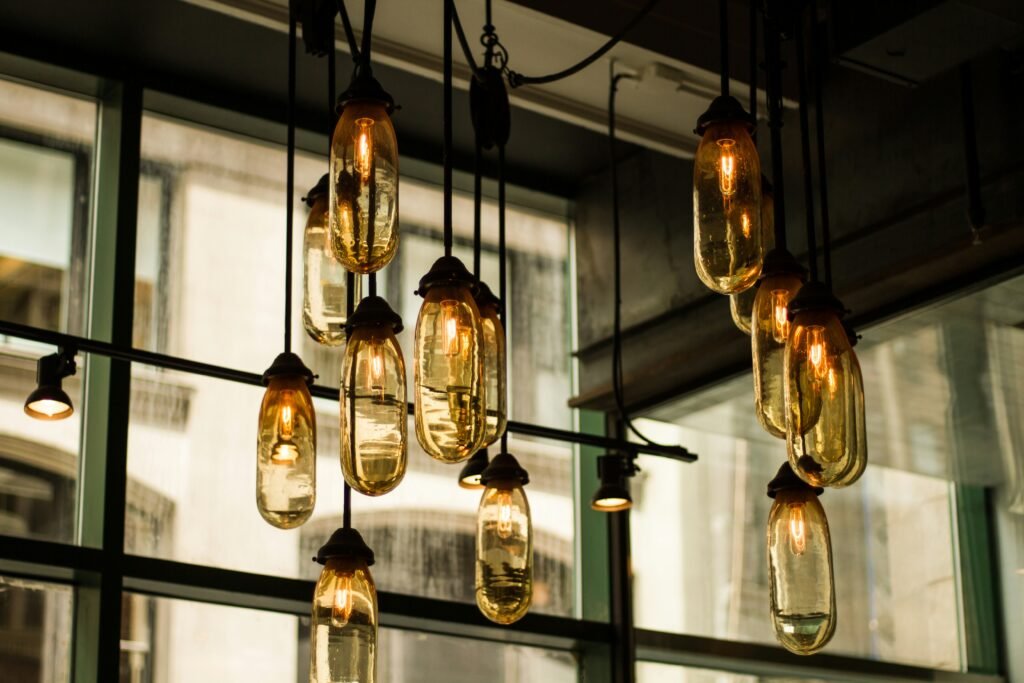In the fast-paced world of modern kitchens, efficiency is key. From meal preparation to cleaning up, every second counts. That’s where innovative kitchen lighting solutions come in, offering a seamless blend of style and functionality. With energy-efficient options that not only enhance the aesthetics of your space but also reduce your carbon footprint, these lights are a game-changer. Say goodbye to dark corners and hello to a well-lit, productive cooking experience. Whether you’re a professional chef or a home cook, these lighting solutions are sure to elevate your efficiency in the kitchen.
LED Lighting
Advantages of LED Lighting
LED lighting has become increasingly popular in recent years, and for good reason. One of the main advantages of LED lighting is its energy efficiency. LEDs use significantly less energy than traditional lighting options, which can help to reduce your energy bills and minimize your environmental impact. LED lights also have a longer lifespan compared to other types of bulbs, which means that they don’t need to be replaced as often, saving you money in the long run.
Different Types of LED Lights
LED lights come in various shapes and sizes, making them versatile for different lighting applications. Some popular types of LED lights include LED bulbs, LED strips, and LED spotlights. LED bulbs can replace traditional incandescent or halogen bulbs and provide a bright, focused light. LED strips are flexible and can be used for accent lighting or to illuminate under cabinets. LED spotlights are perfect for highlighting specific areas or objects in your kitchen, such as artwork or countertops.
Integration of LED Lights in Kitchen Design
LED lights can be seamlessly integrated into your kitchen design, adding both functionality and style. LED strips can be installed under cabinets, along the edges of shelves, or even above upper cabinets to create a warm and inviting ambiance. LED spotlights can be strategically placed to highlight key features in your kitchen, such as a statement backsplash or a beautiful kitchen island. The flexibility and versatility of LED lights allow you to customize your kitchen lighting to suit your needs and preferences.
Smart Lighting Systems
Benefits of Smart Lighting Systems
Smart lighting systems offer a whole new level of convenience and control in your kitchen. With smart lighting, you can easily adjust the brightness and color temperature of your lights to create the perfect ambiance for any occasion. Smart lighting systems also provide the ability to remotely control your lights using your smartphone or tablet, giving you the convenience of controlling your kitchen lighting from anywhere in your home.
Wireless Control and Automation
One of the key advantages of smart lighting systems is the wireless control and automation capabilities they offer. Through the use of wireless technology, you can control your kitchen lights with a simple tap on your smartphone or by using voice commands with a compatible voice assistant. With automation features, you can set schedules for your lights to turn on and off at specific times, helping to save energy and provide added security when you’re away from home.
Integration with Voice Assistants and Home Automation
Smart lighting systems can be seamlessly integrated with popular voice assistants, such as Amazon Alexa or Google Assistant. This means that you can control your kitchen lights with simple voice commands, making it incredibly convenient and hands-free. Additionally, smart lighting systems can also be integrated with other smart home devices and automation systems, allowing you to create custom scenes and routines that suit your lifestyle and preferences.

This image is property of images.unsplash.com.
Task Lighting
Importance of Task Lighting in the Kitchen
Task lighting plays a crucial role in the kitchen, as it provides focused illumination for specific activities such as food preparation, cooking, and cleaning. Having adequate task lighting in your kitchen ensures that you can perform these tasks efficiently and safely, reducing the risk of accidents and improving overall productivity. A well-lit kitchen also enhances visibility, allowing you to easily see and assess the quality of your ingredients and food.
Placement and Types of Task Lights
When it comes to task lighting in the kitchen, proper placement and the right types of lights are essential. Under-cabinet lights are commonly used as task lights, as they provide direct illumination to the countertop area where most food preparation takes place. Pendant lights or track lighting above the kitchen island or sink can also serve as effective task lights. It’s important to choose task lights that offer a bright, focused beam of light, such as LED spotlights or adjustable LED track lights, to ensure optimal illumination for your specific tasks.
Enhancing Efficiency and Visibility
By incorporating task lighting into your kitchen design, you can greatly enhance efficiency and visibility. With well-placed task lights, you can easily see what you’re doing while chopping vegetables, measuring ingredients, or reading recipes. This not only improves your accuracy but also reduces eye strain and fatigue. Additionally, the focused and brighter lighting provided by task lights allows you to work with precision, resulting in better cooking and baking outcomes.
Under Cabinet Lighting
Benefits of Under Cabinet Lighting
Under cabinet lighting is an excellent addition to any kitchen, providing both functional and aesthetic benefits. One of the main advantages of under cabinet lighting is that it illuminates the countertop area, making tasks such as food preparation and cooking easier and safer. It eliminates shadows and dark spots, ensuring that you have a well-lit workspace at all times. Additionally, under cabinet lighting adds a subtle and inviting glow to your kitchen, creating a warm and welcoming atmosphere.
Different Under Cabinet Lighting Options
There are several options to choose from when it comes to under cabinet lighting. LED strip lights are a popular choice, as they are flexible, energy-efficient, and can be easily installed along the underside of your cabinets. LED puck lights are another option, providing a focused and bright light that can be recessed or surface-mounted under the cabinets. LED tape lights offer a continuous strip of light and can be customized to fit the length of your cabinets. Ultimately, the choice of under cabinet lighting will depend on your aesthetic preferences and the level of brightness you desire.
Creating a Functional and Aesthetic Kitchen
Under cabinet lighting not only enhances the functionality of your kitchen but also adds a touch of elegance to the space. It highlights the beauty of your countertops and backsplash, drawing attention to these key design elements. Under cabinet lighting can also be used to create visual interest and depth in your kitchen, especially when combined with other types of lighting, such as overhead fixtures or pendant lights. With the right under cabinet lighting, you can transform your kitchen into a functional and visually appealing space.

This image is property of images.unsplash.com.
Dimmable Lighting
Advantages of Dimmable Lighting
Dimmable lighting offers flexibility and control over the ambiance of your kitchen. With dimmable lights, you can easily adjust the brightness levels to create the desired mood or atmosphere. Whether you want bright, vibrant lighting for cooking and food preparation or a soft, cozy glow for entertaining guests, dimmable lighting allows you to achieve the perfect lighting for any occasion. Dimmable lights also offer energy-saving benefits, as they allow you to reduce the light output and save electricity.
Ambiance Control and Energy Savings
Having the ability to control the ambiance of your kitchen with dimmable lighting is a game-changer. You can dim the lights during intimate gatherings or romantic dinners to create a warm and inviting atmosphere. Alternatively, you can brighten the lights for a lively family dinner or when you need to focus on intricate cooking tasks. By adjusting the brightness levels according to your needs, you can create the perfect ambiance while saving energy and prolonging the lifespan of your bulbs.
Variety of Dimming Options
There are several options available for dimming your kitchen lights. Traditional wall dimmer switches are a popular choice and allow you to manually adjust the brightness level by turning a dial or sliding a switch. Another option is the use of remote control dimmers, which give you the flexibility to adjust the lighting from anywhere in the room. Additionally, smart lighting systems mentioned earlier often include dimming capabilities that can be controlled via voice commands or smartphone apps. The variety of dimming options allows you to choose the method that best suits your preferences and lifestyle.
Natural Lighting
Harnessing Natural Light in the Kitchen
Natural lighting can transform your kitchen, providing a bright and refreshing environment. By incorporating windows, skylights, or glass doors into your kitchen design, you can maximize the amount of natural light that enters the space. Natural light has been shown to improve mood, enhance productivity, and even positively affect our circadian rhythm. Embracing natural lighting in your kitchen can create a healthier and more enjoyable cooking and dining experience.
Design Considerations for Maximizing Natural Light
To make the most of natural light in your kitchen, careful consideration should be given to its design. Positioning windows strategically can help to maximize the amount of sunlight that enters the space. Placing them on south-facing walls tends to provide the most consistent and intense sunlight throughout the day. Using reflective surfaces, such as light-colored countertops or backsplash tiles, can help to bounce natural light around the room, further enhancing its impact. Additionally, minimizing obstructions near windows, such as tall cabinets or thick curtains, can ensure that sunlight is not blocked.
Combining Natural and Artificial Lighting
While natural lighting is desirable, it may not always be sufficient, especially during evening hours or in darker areas of the kitchen. Combining natural and artificial lighting can provide the best of both worlds. By strategically placing artificial lights near areas that receive less natural light, you can ensure consistent and adequate illumination throughout your kitchen. This combination allows you to enjoy the benefits of natural light during the day and seamlessly transition to artificial lighting when needed.

This image is property of images.unsplash.com.
Energy-Efficient Bulbs
Choosing Energy-Efficient Bulbs
Opting for energy-efficient bulbs is both environmentally friendly and cost-effective. One of the most popular types of energy-efficient bulbs is LED bulbs, which offer a significant reduction in energy consumption compared to traditional incandescent or halogen bulbs. LED bulbs convert a higher percentage of energy into light, rather than heat, resulting in less wasted energy. Other options for energy-efficient bulbs include CFL (Compact Fluorescent Lamp) bulbs and halogen incandescent bulbs, both of which consume less energy and have a longer lifespan than traditional incandescent bulbs.
Comparison of Bulb Types
LED bulbs, CFL bulbs, and halogen incandescent bulbs all have their advantages and disadvantages. LED bulbs are the most energy-efficient and longest-lasting, but they are initially more expensive than other options. CFL bulbs are affordable and energy-efficient, but they contain trace amounts of mercury, requiring proper disposal. Halogen incandescent bulbs are the least energy-efficient but offer a warm and familiar glow. When choosing energy-efficient bulbs, it’s important to consider factors such as energy savings, lifespan, upfront cost, and the desired quality of light.
Longevity and Cost Savings
One of the significant benefits of energy-efficient bulbs is their longevity and cost savings. LED bulbs, in particular, have an exceptionally long lifespan, with some models capable of lasting up to 25,000 hours or more. This means that you won’t have to replace them as frequently, saving you money on replacements. Additionally, energy-efficient bulbs consume less electricity, resulting in lower energy bills. Over time, the cost savings from using energy-efficient bulbs can quickly add up, making them a smart investment for your kitchen lighting needs.
Sensor Lighting
Benefits of Sensor Lighting
Sensor lighting provides convenience and energy efficiency in your kitchen. With sensor lights, you don’t have to fumble for a light switch or worry about leaving lights on when you leave the room. Sensor lights automatically turn on when they detect motion and turn off when there is no activity detected for a certain period. This not only saves energy but also provides added security by giving the impression that someone is present in your kitchen.
Motion Sensors for Energy Conservation
Motion sensors are commonly used in kitchens to conserve energy. By automatically turning on the lights when you enter the room and turning them off when you leave, motion sensor lights ensure that lights are only used when necessary. This eliminates the need for manually switching lights on and off and reduces the chances of lights being accidentally left on for long periods. Motion sensor lights are especially useful in areas such as pantries or kitchen cabinets, where lighting may only be required for short durations.
Automatic Lighting Activation
Sensor lighting can make your daily tasks in the kitchen more convenient. Imagine having your kitchen lights automatically turn on as soon as you enter, allowing you to focus on your cooking or meal preparation without searching for light switches. Sensor lights can also be beneficial when your hands are full or dirty, eliminating the need to touch switches and potentially spreading germs. With automatic lighting activation, your kitchen becomes a hassle-free and efficient space, enhancing your overall experience.
Lighting Control and Automation
Control Systems for Efficient Lighting
Lighting control systems offer advanced control and automation features for your kitchen lighting. These systems allow you to control multiple lights simultaneously, adjust brightness levels, and create customized lighting scenes or schedules. With a lighting control system, you can easily switch between ambient, task, and accent lighting to suit your needs and preferences. This level of control not only enhances the functionality of your kitchen but also adds a layer of convenience to your daily routines.
Smart Switches and Timers
Smart switches and timers are essential components of lighting control systems. Smart switches can be installed in place of traditional light switches, allowing you to control your kitchen lights remotely using your smartphone or tablet. Timers provide the ability to schedule your lights to turn on and off at specific times, ensuring that you never have to enter a dark kitchen or worry about leaving lights on overnight. With smart switches and timers, you have full control over your kitchen lighting, even when you’re away from home.
Adjustable Lighting Schedules
Another advantage of lighting control systems is the ability to set adjustable lighting schedules. This feature allows you to program your lights to automatically turn on and off at different times throughout the day, mimicking natural lighting patterns. For example, you can schedule your kitchen lights to gradually brighten in the morning to simulate the rising sun, and gradually dim in the evening to create a relaxing ambiance. Adjustable lighting schedules not only enhance the aesthetics of your kitchen but also promote a healthier circadian rhythm.
Lighting Design Tips
Considerations for Kitchen Lighting Design
When designing your kitchen lighting, it’s important to consider the overall layout and functionality of the space. Start by identifying the different zones or areas within your kitchen, such as cooking, dining, and food prep areas. Each zone may require different lighting levels and types of fixtures. Additionally, take into account the placement of windows and natural light sources, as well as any architectural or design features you want to highlight. By considering these factors, you can create a lighting design that is both practical and visually appealing.
Layering and Mixing Different Types of Lighting
Layering and mixing different types of lighting is key to achieving a balanced and functional kitchen. Start with ambient lighting as the foundation, which provides overall illumination to the entire space. This can be achieved through recessed ceiling lights or flush-mounted fixtures. Next, add task lighting in specific areas where focused illumination is needed, such as under cabinets or above the sink. Accent lighting can then be used to highlight architectural features or decor items, creating visual interest. By combining these different layers of lighting, you can create a well-lit kitchen that meets all your lighting needs.
Creating a Balanced and Functional Space
The ultimate goal of kitchen lighting design is to create a balanced and functional space that enhances both aesthetics and practicality. Ensure that your lighting design provides adequate illumination for all tasks, from food preparation to dining. Avoid creating shadows or glare by positioning lights at the appropriate angles and heights. Consider using dimmable lights to adjust brightness levels according to your needs. By carefully planning your kitchen lighting design and considering the specific requirements of each area, you can create a cohesive and inviting space where functionality meets style.
In conclusion, elevating efficiency in the kitchen through innovative lighting solutions is possible with the wide range of options available. LED lighting offers energy efficiency and versatility, while smart lighting systems provide convenience and automation. Task lighting, under cabinet lighting, dimmable lighting, natural lighting, sensor lighting, and energy-efficient bulbs all contribute to enhancing the functionality and aesthetics of your kitchen. By considering the various types of lighting, their benefits, and how they can be integrated into your kitchen design, you can create a well-lit space that is not only efficient but also visually appealing. With careful planning and attention to detail, you can transform your kitchen into a functional and inviting area where cooking and gathering becomes a delightful experience.
